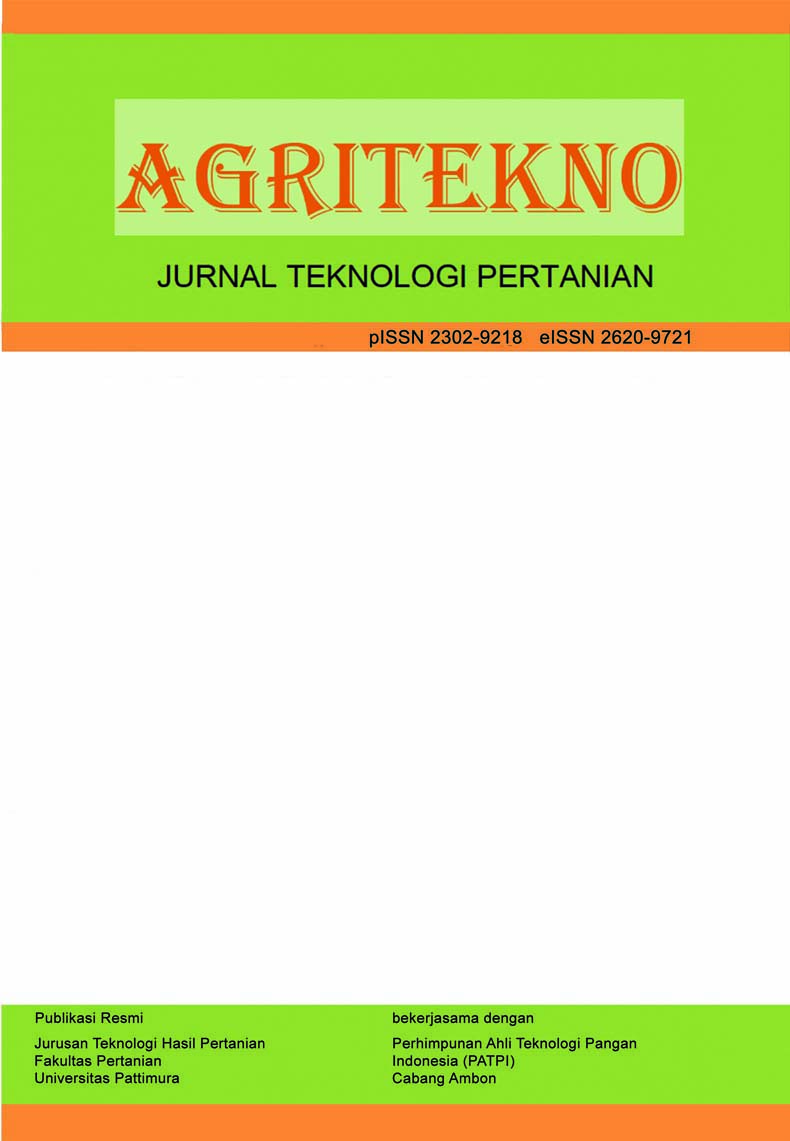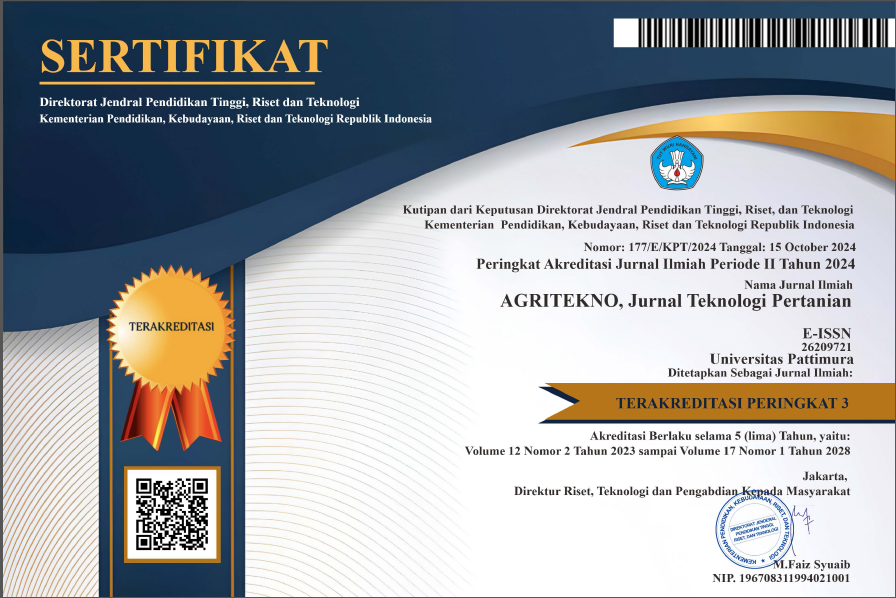Formulasi Es Krim Nabati Berbasis Sari Kedelai dan Sari Sorgum dengan Pengental Xanthan Gum
Plant-Based Ice Cream Based on Soybean-Sorghum Extract with Xanthan Gum as Thickener
Abstract
The trend of low-fat consumption is not only limited to main meals, but also to desserts. Ice cream, which is usually made from milk, is replaced by plant-based ingredients that have low fat content but high protein such as soybean juice and sorghum juice. The purpose of this study was to obtain the best plant-based ice cream formulation with the ratio of soybean juice and sorghum juice and the use of xanthan gum as a stabilizer. The method in this study was a completely randomized design with two treatments, namely three ratios of soybean juice and sorghum juice (30:70; 50:50; 70:30) and two concentrations of xanthan gum (0.3% and 0.5%). Physical quality parameters observed were overrun and melting time, chemical quality parameters were proximate and sensory quality parameter which were taste, aroma, texture and overall acceptance. The three best treatments were then analyzed for functional value in the form of total phenolics, flavonoids and antioxidant activity. Statistical analysis used One Way ANOVA with Duncan's difference test. The results showed that the ratio of soybean juice and sorghum juice and the concentration of xanthan gum had a significant effect on physical, chemical and sensory parameters. Ice cream with a ratio of 30:70 and a concentration of 0.3% xanthan gum produced the highest overrun value of 39.71% but the longest melting time was obtained in the treatment of a ratio of 50: 50 and 0.5% xanthan gum concentration of 1005.98 seconds or 16.77 minutes. Based on functional analysis, the highest total phenolics, flavonoids and antioxidant activity were obtained in the ice cream treatment of soybean juice and sorghum juice 50:50 with the addition of xanthan gum as much as 0.5% as a stabilizer.
Downloads
References
Agustina, M., Fahrizal, F., & Indarti, E. (2019). Penambahan CMC, gum xanthan, dan pektin sebagai stabilizer pada sirup air kelapa. Jurnal Ilmiah Mahasiswa Pertanian, 4(2), 266–273. https://doi.org/10.17969/jimfp.v4i2.10966
Akbari, M., Eskandari, M. H., & Davoudi, Z. (2019). Application and functions of fat replacers in low-fat ice cream: A review. Trends in Food Science & Technology, 86, 34–40. https://doi.org/10.1016/j.tifs.2019.02.036
Anggi, A., Rahayu, W. M., & Rahmadhia, S. N. (2024). Sifat fisikokimia dan organoleptik es krim sari kecambah kedelai hitam (Glycine max Var. Mallika) dengan variasi pengemulsi. Jurnal PANGAN, 33(2). https://doi.org/10.33964/jp.v33i2.792
Asshidiqy, R., Putri, W. D. R., & Maligan, J. M. (2020). Optimasi elisitasi suhu dan waktu kejut listrik untuk meningkatkan aktivitas antioksidan dan kandungan total fenol kacang kedelai (Glycine max). Jurnal Keteknikan Pertanian Tropis an Biosistem, 8(2), 153–160. https://doi.org/10.21776/ub.jkptb.2020.008.02.05
Avif, A. N., & Dewi, A. O. T. (2022). Analisis kandungan zat gizi, fenol, flavonoid, fitat, dan tanin pada sorgum (Sorgum bicolor (L.) Moench). Nutri-Sains: Jurnal Gizi, Pangan Dan Aplikasinya, 6(2), 65–74. https://doi.org/10.21580/ns.2022.6.2.7083
Binuni, R., Maarisit, W., Hariyadi, H., & Saroinsong, Y. (2020). uji aktivitas antioksidan ekstrak daun mangrove Sonneratia alba dari Kecamatan Tagulandang, Sulawesi Utara menggunakan metode DPPH. Biofarmasetikal Tropis, 3(1), 79–85. https://doi.org/10.55724/j.biofar.trop.v3i1.260
Darma, A., Sumitro, K. R., Jo, J., & Sitorus, N. (2024). Lactose intolerance versus Cow’s Milk Allergy in infants: A clinical dilemma. Nutrients, 16(3), 414. https://doi.org/10.3390/nu16030414
Genovese, A., Balivo, A., Salvati, A., & Sacchi, R. (2022). Functional ice cream health benefits and sensory implications. Food Research International, 161, 111858. https://doi.org/10.1016/j.foodres.2022.111858
Gulcin, İ., & Alwasel, S. H. (2023). DPPH radical scavenging assay. Processes, 11(8), 2248. https://doi.org/10.3390/pr11082248
Hariono, B., Kautsar, S., Brilliantina, A., Kurnianto, M. F., & Wijaya, R. (2023). The study of shelf-life of soymilk treated by pasteurization methods by using organoleptic test. Rona Teknik Pertanian, 16(1), 27–34. https://doi.org/10.17969/rtp.v16i1.29445
Hermanto, H., Onasis, J. A., & Priyanto, G. (2023). Pengaruh jenis minyak nabati terhadap karakteristik mayones dengan bahan penstabil gum xanthan. Journal of Scientech Research and Development, 4(2), 210–227. https://doi.org/10.56670/jsrd.v4i2.68
Hizmadin, A., Sumual, M. F., & Djarkasi, G. S. S. (2024). Penambahan carboxymethyl celullose (CMC) pada susu kacang kenari (Canarium indicum, L.) untuk meningkatkan stabilitas emulsi dan tingkat kesukaan panelis. Jurnal Teknologi Pertanian (Agricultural Technology Journal, 14(2), 80–90. https://doi.org/10.35791/jteta.v14i2.49855
Irawan, I., Ardhanawinata, A., Khasanah, U., Diachanty, S., & Zuraida, I. (2024). Karakteristik fisikokimia dan mutu hedonik es krim dengan penambahan bubur rumput laut. Jurnal Pengolahan Hasil Perikanan Indonesia, 27(2), 132–141. https://doi.org/10.17844/jphpi.v27i2.48012
Isdamayani, L., & Panunggal, B. (2015). Kandungan flavonoid, total fenol, dan antioksidan snack bar sorgum sebagai alternatif makanan selingan penderita diabetes mellitus tipe 2. Journal of Nutrition College, 4(4), 342–349. https://doi.org/10.14710/jnc.v4i4.10108
Istiqomah, K., Praptiningsih, Y., & Windrati, W. S. (2018). Karakterisasi es krim edamame dengan variasi jenis dan jumlah penstabil. Jurnal AGROTEKNOLOGI, 11(02), 139. https://doi.org/10.19184/j-agt.v11i02.6522
Latifah, R. , N. (2022). Analisis pembuatan susu kedelai dengan gula kulit singkong (skgks) terhadap kadar nutrisi dan uji aktivitas anti bakteri coliform. Chempublish Journal, 6(2), 90–102.
Leal, M. R. S., Albuquerque, P. B. S., Rodrigues, N. E. R., Silva, P. M. dos S., de Oliveira, W. F., Correia, M. T. dos S., Kennedy, J. F., & Coelho, L. C. B. B. (2024). A review on the use of polysaccharides as thickeners in yogurts. Carbohydrate Polymer Technologies and Applications, 8, 100547. https://doi.org/10.1016/j.carpta.2024.100547
Marwati, Prasetyo, R. ,A, & Yuliani. (2021). Respons sensoris dan waktu leleh es krim nabati berbahan sari kedelai dan pisang mauli (Musa sp). Journal of Tropical AgriFood, 1, 15–22. https://doi.org/10.35941/jtaf.3.1.2021.5660.15-22
Murtini, E. S. (Ed.). (2021). Sorgum dan Pemanfaatannya dalam Industri Pangan. FTP-UB Press.
Ntau, E., Djarkasi, G. S. S., Lalujan, L. E., Studi, P., Pangan, T., Pertanian, F., & Manado, U. (2021). Pengaruh penambahan gelatin terhadap kualitas fisik es krim sari jagung manis. Sam Ratulangi Journal of Food Research, 1(1), 10–19. https://ejournal.unsrat.ac.id/v3/index.php/srjfr/article/view/33899
Nusa, M. I., MD, M., & Hakim, F. A. (2019). Identifikasi mutu fisik kimia dan organoleptik penambahan ekstrak jahe (Zingiber officinale) pada pembuatan es krim sari kacang hijau (Phaseolus Radiatus L.). Agrintech: Jurnal Teknologi Pangan Dan Hasil Pertanian, 2(2), 47–51. https://doi.org/10.30596/agrintech.v2i2.3433
Oktafiyani, A., Susilo, D. U. M. (2019). Pembuatan es krim ubi jalar ungu dengan variasi jumlah siklus pengocokan-pembekuan. Jurnal Pertanian dan Pangan, 1(2), 20–26.
Panjaitan, G. P. R., Uray, R. S., Rahmah, A., Marda Lorensa, S., Mandasari, J., Imakulata Tumiang, K., Setiyawati, N., Reza, M., & Irvandi, D. (2024). Workshop on making coconut milk ice cream as a business opportunity for PKK women in Sungai Itik Village. International Journal of Public Devotion, 7(1), 21–29. https://doi.org/10.26737/IJPD.V7I1.4680
Picauly, P., Talahatu, J., & Mailoa, M. (2015). Pengaruh penambahan air pada pengolahan susu kedelai. AGRITEKNO: Jurnal Teknologi Pertanian, 4(1), 8–13.
Puspitasari, A., Wahyuni, F., Suherman, S., Siradjuddin, N. N., & Syafruddin, S. (2021). Identifikasi daya leleh dan overrun serta analisis kadar zat besi (Fe) es krim dengan penambahan tepung daun kelor (Moringa Oleifera). PREPOTIF : Jurnal Kesehatan Masyarakat, 5(2), 980–986. https://doi.org/10.31004/prepotif.v5i2.2233
Putra, R. , T., Albaarri, A. , N., & Hintono, A. (2024). Pengaruh penambahan garam terhadap off flavour pada susu edamame (Glycine max L.). Jurnal Teknologi Pangan, 8(1), 18–21.
Qamar, A. S. (2016). Impact of Stabilizers on Ice Cream Quality Characteristics. MOJ Food Processing & Technology, 3(1). https://doi.org/10.15406/mojfpt.2016.03.00063
Rafiyanti, C. V., Hasni, D., & Sulaiman, M. I. (2018). Studi pembuatan es krim nabati dengan variasi sumber karbohidrat dan konsentrasi lesitin sebagai emulsifier. Jurnal Ilmiah Mahasiswa Pertanian, 3(3), 176–184. https://doi.org/10.17969/jimfp.v3i3.8193
Salsabila, D. M., Alifiani, N., Islam, N., Febriana, S., & Nisa, T. C. (2022). Aktivitas antioksidan dan total flavonoid es krim naga merah dan lidah buaya sebagai nonfarmakoterapi DMT2. Jurnal Teknologi Pangan dan Kesehatan (The Journal of Food Technology and Health), 4(1), 01–10. https://doi.org/10.36441/jtepakes.v4i1.827
Seno, B. A., & Lewerissa, K. B. (2021). Kualitas fisikokimia dan organoleptik gelato tempe dengan penggunaan beberapa jenis starch –based fat replacer. Jurnal Teknologi Pangan, 14(2). https://doi.org/10.33005/jtp.v14i2.2448
USDA. (2019). Full Report (All Nutrients). National Nutrient Database for Standard Reference.
Widyawati, S. P., Ristiarini, S., Werdani, Y. D., Kuswardani, I., & Novita Herwina Irene. (2019). Perubahan sifat fisikokimia dan organoleptik sari kedelai dengan penambahan air seduhan beluntas. Jurnal Teknologi Pangan Dan Gizi, 18(2), 98–111.
Yulifianti, R., Muzaiyanah, S., & Utomo, J. S. (2018). Kedelai sebagai bahan pangan kaya isoflavon. Buletin Palawija, 16(2), 84. https://doi.org/10.21082/bulpa.v16n2.2018.p84-93
Copyright (c) 2025 The Author(s)

This work is licensed under a Creative Commons Attribution-ShareAlike 4.0 International License.
Authors who publish with this journal agree to the following terms:
- Authors retain copyright and grant the journal the right of first publication with the work simultaneously licensed under a Creative Commons Attribution License that allows others to share the work with an acknowledgement of the work's authorship and initial publication in this journal.
- Authors are able to enter into separate, additional contractual arrangements for the non-exclusive distribution of the journal's published version of the work (e.g., post it to an institutional repository or publish it in a book), with an acknowledgement of its initial publication in this journal.
- Authors are permitted and encouraged to post their work online (e.g., in institutional repositories or on their website) prior to and during the submission process, as it can lead to productive exchanges, as well as earlier and greater citation of published work (See The Effect of Open Access).









